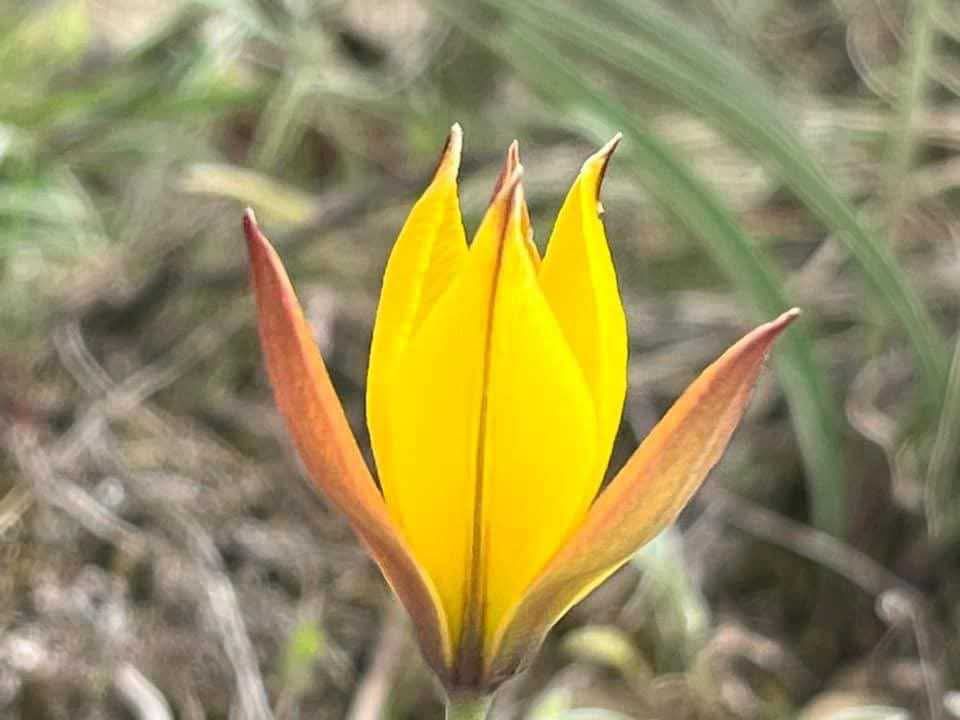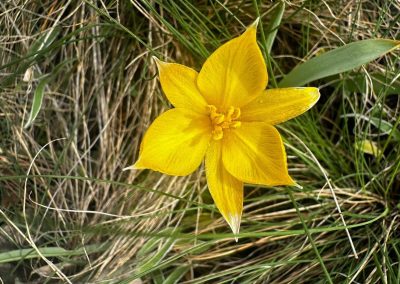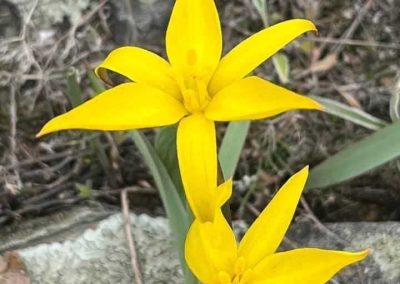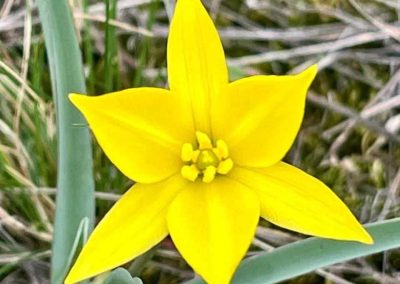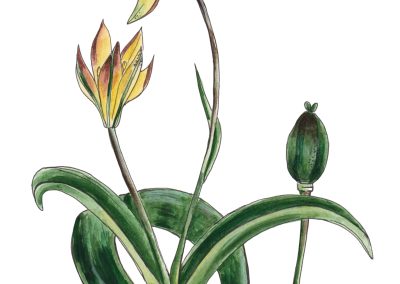Tulipa sylvestris
Scientific description
Phylum: Angiospermatophyta (Magnoliophyta)
Class: Monocotyledonatae (Liliatae)
Subclass: Liliidae
Order: Liliales
Family: Liliaceae
Common name: yellow tulip.
Origin: native to central European areas.
Description:
Herbaceous, perennial plant with ovate dark brown underground bulb. Stem twisted, ~30 cm tall, usually single-flowered. Leaves flat, pointed, parallel-veined, pale bluish-green. Flower solitary, yellow, campanulate: six free tepals arranged in two cycles (3 external, 3 internal). Androecium: six stamens, two cycles. Gynoecium superior, elongated cylindrical ovary, no style, sessile trilobed stigma (3 carpels). Fruit: capsule. Blooms March–April. Listed as vulnerable/rare in Romania.
Propagation: by bulbs, bulbils, seeds.
Ecology:
Vulnerable species, grows in clearings, thickets, meadows; prefers siliceous, well-drained humic soils with moderate humidity.
Uses:
Planted in gardens, parks as decorative plant. Leaves and bulbs contain toxic alkaloids: leucoine and leukocytin.
Hazard: Vulnerable/rare species.
Încrengătura: Angiospermatophyta (Magnoliophyta)
Clasa: Monocotyledonatae (Liliatae)
Subclasa: Liliidae
Ordinul: Liliales
Familia: Liliaceae
Denumire populară: lalea galbenă.
Origine: central europeană.
Descrierea:
Plantă ierboasă, perenă, cu bulb subteran oval, maro-închis. Tulpina șerpuită, ~30 cm, unifloră. Frunze plate, vârf ascuțit, nervațiune paralelă, verde palid-albăstrui. Floare solitară, galbenă, campanulată: șase tepale libere, două cicluri (3 externe, 3 interne). Androceul: șase stamine în două cicluri. Gineceul superior, ovar cilindric, fără stil, stigmat sesil trilobat (3 carpele). Fruct capsulă. Înflorește martie–aprilie. Menționată ca vulnerabilă/rară în România.
Înmulțire: prin bulbi, bulbili și semințe.
Ecologia:
Specie vulnerabilă, crește spontan în poieni, tufărișuri, pajiști; preferă soluri humice silicioase, bine drenate, cu umiditate moderată.
Utilizare:
Plantă decorativă în grădini și parcuri. Frunze și bulbii conțin alcaloizi toxici: leucoina și leicocitina.
Pericol: Vulnerabilă/rară conform Listei Roșii (Oltean et al, 1994).
Φυλοταξία: Angiospermatophyta (Magnoliophyta)
Κλάση: Monocotyledonatae (Liliatae)
Υποκλάση: Liliidae
Τάξη: Liliales
Οικογένεια: Liliaceae
Δημοφιλές όνομα: κίτρινη τουλίπα.
Καταγωγή: Κεντρική Ευρώπη.
Περιγραφή:
Πολυετές ποώδες φυτό με οβάλ, καστανό-σκούρους βολβούς. Κορμός ελικοειδής, ~30 εκ., συνήθως ένα άνθος. Φύλλα επίπεδα, μυτερά, παράλληλες νευρώσεις, ανοιχτό πράσινο-μπλε. Άνθος μοναχικό, κίτρινο, καμπανοειδές: 6 ελεύθερα τεμάχη (τεπάλη), δύο κύκλοι (3 εξωτερικά, 3 εσωτερικά). Ανδρόκηπος: 6 στήμονες, δύο κύκλοι. Ύπερος ανώτερος, ωοθήκη επιμήκης κυλινδρική, χωρίς στυλό, τριλοβικό στίγμα (3 καρπόφυλλα). Καρπός: κάψουλα. Ανθίζει Μάρτιο–Απρίλιο.
Αναπαραγωγή: μέσω βολβών, βολβιλίων και σπόρων.
Οικολογία:
Ευάλωτο είδος, αυθόρμητη ανάπτυξη σε λιβάδια, θάμνους και πεδιάδες. Προτιμά πλούσια σε σιλικόνη, καλά αποστραγγιζόμενα εδάφη, μέτρια υγρασία.
Χρήση:
Φυτεύεται σε κήπους και πάρκα ως διακοσμητικό φυτό. Φύλλα και βολβοί περιέχουν τοξικούς αλκαλοειδείς: λευκοΐνη και λεικοκιτίνη.
Κίνδυνος: Ευάλωτο/σπάνιο είδος (Oltean et al, 1994).
Phylum : Angiospermatophyta (Magnoliophyta)
Classe : Monocotyledonatae (Liliatae)
Sous-classe : Liliidae
Ordre : Liliales
Famille : Liliaceae
Noms communs : tulipe jaune.
Origine : régions centrales d'Europe.
Description :
Plante herbacée vivace avec bulbe souterrain ovale brun foncé. Tige torsadée ~30 cm, généralement une fleur. Feuilles plates, pointues, nervures parallèles, vert bleuâtre pâle. Fleur solitaire, jaune, campanulée: 6 tépales libres, 2 cycles (3 externes, 3 internes). Androcée: 6 étamines, 2 cycles. Gynécée supérieur, ovaire allongé cylindrique, sans style, stigmate trilobé sessile (3 carpelles). Fruit: capsule. Floraison mars–avril. Espèce vulnérable/rare en Roumanie.
Multiplication : par bulbes et graines.
Écologie :
Espèce vulnérable, pousse spontanément dans clairières, fourrés, prairies; préfère sols siliceux bien drainés, humifères, humidité modérée.
Utilisation :
Plantée comme plante ornementale dans jardins et parcs. Feuilles et bulbes contiennent alcaloïdes toxiques: leucoïne et leucocitine.
Danger : Espèce vulnérable/rare.
Creative writing inspired by Tulipa sylvestris
Written by
Rotaru Andreea
Merve Sevdanur Meral
The Painter of Golden Tulips
In idyllic Dutch town Delft, where silver-cutting waters ran through cobblestone streets, lived a poor and young painter, Jan. Soft of heart and gifted hand, Jan painted the world not for gold, but because he loved beauty itself.
Down the street, in a house of beauty, dwelt Elise, the daughter of the wealthy merchant Hendrik. With hair as bright as sunlight and a mind as sharp, she was adored by all, but no suitor made her heart glow.
On a spring day when the tulip fields spread their golden robes along the landscape, Jan sat on the canal to paint. Before him stood a vision: a yellow tulip, shining like bottled sunshine. He painted with uncommon fervour, unaware that he was being watched.
Elise, drawn in by the fragrance of the blooms and the quiet rhythm of the brush, stopped to examine his own work. Their eyes met—hers soft, his awed. They said little, but something ancient circulated between them.
She returned each day, and their passion intensified. But someone talked, and tales reached her father's ear. Hendrik was enraged. He forbade Elise from going near the poor artist. Their love, he shouted, was folly. And with that, he banned her from the studio.
Broken but unflappable, Jan went back to an old tale his grandmother told him—one about Flora, Roman flower goddess. She had sanctified the yellow tulip as a token of hopeless love, a love that remains even if fortune catches up with it.
Jan began a final painting: Elise, bathed in golden light, surrounded by a sea of yellow tulips. It was not just her face, but her essence—the very essence of their love, immortalized in oil and light.
When Hendrik viewed the painting, something inside him shifted. He did not view poverty, but reality—true love, the kind that money could not buy. At last, he gave his consent.
Elise and Jan embraced beneath the tulip fields, as petals danced on the wind like Flora's benediction.
Even today, when yellow tulips unfurl, lovers remember the tale. They say that if you receive one at dawn, and hold it against your heart, real love will come to you—gentle, golden, and brave.


